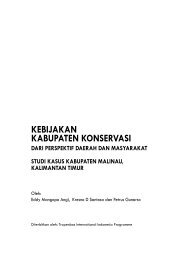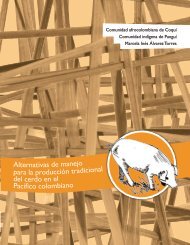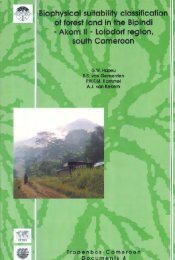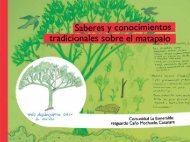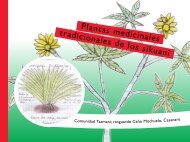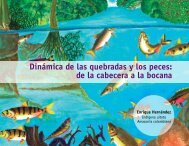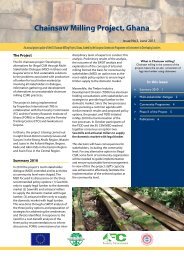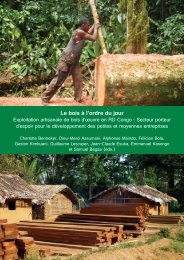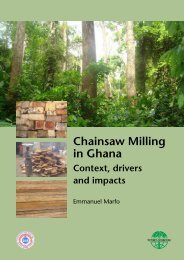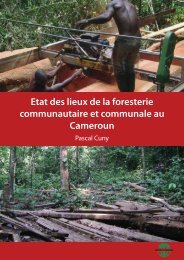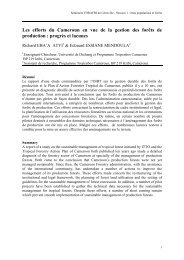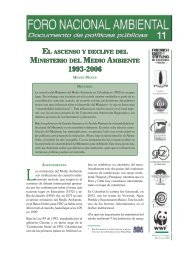Download the publication - Tropenbos International
Download the publication - Tropenbos International
Download the publication - Tropenbos International
Create successful ePaper yourself
Turn your PDF publications into a flip-book with our unique Google optimized e-Paper software.
Plant diversity in a Central African rain forest: Implications for biodiversity conservation in Cameroon<br />
Pleistocene vegetation changes in Central Africa<br />
Maley (1993) has identified four main climatic phases of <strong>the</strong> late Quaternary in<br />
Central Africa. The Maluekian (c. 70,000 to 40,000 BP) which corresponds to a<br />
relatively dry period marked by extensive forest retreat. The Njilian, lasting from<br />
40,000 to 30,000 BP that was relatively wet and marked by a definite extension of<br />
forest. The Leopoldian (c. 30,000 to 12,000 BP) that culminated around 18,000 BP<br />
was relatively dry and marked by a new extension of open savanna environments.<br />
The Kibangian (c. 12,000 BP to <strong>the</strong> present) was relative wet until c. 3500 BP<br />
(Kibangian A) and marked by a new phase of forest extension. Later, came ano<strong>the</strong>r<br />
drier period from 3500 BP to present (Kibangian B) corresponding to <strong>the</strong> begining<br />
of ano<strong>the</strong>r extension of savanna in some parts of Central Africa. According to <strong>the</strong><br />
refugium <strong>the</strong>ory, Central African rain forest underwent a series of climatic<br />
fluctuations in <strong>the</strong> late Pleistocene during which a considerable portion of <strong>the</strong><br />
tropical lowland rain forest was repeatedly reduced to relatively small isolated<br />
patches, called forest refuges, due to unfavourable climatic conditions (Hamilton,<br />
1982; White, 1993; Maley, 1989, 1990 & 1996). During <strong>the</strong> dry-out phases, some<br />
forest species were captured in <strong>the</strong>se refuges, and some surviving species were not<br />
or hardly capable of migrating out of <strong>the</strong>se again, due to <strong>the</strong>ir extreme low dispersal<br />
abilities (White, 1993).<br />
Geological and palynogical research conducted on lake sediments from several sites,<br />
has shown that c. 2500 BP <strong>the</strong> Central African forest experienced a “catastrophic<br />
destruction” that led to a major extension of <strong>the</strong> savanna (Maley & Brenac, 1998;<br />
Maley, 2002). Detailed pollen records from lake Barombi Mbo in western<br />
Cameroon, lake Ossa in south Cameroon, lake Kitinia in western Congo, lakes<br />
Mboandong and Njupi in south Congo reveal <strong>the</strong> presence of pseudo-periods of<br />
about 2000 to 2500 BP for several tree taxa typical of mature undisturbed forest<br />
(Maley & Elenga, 1993; Elenga et al., 1994 & 1996; Reynaud-Ferrera et al., 1996).<br />
During this phase, <strong>the</strong> rainfall suddenly became more seasonal, reducing <strong>the</strong><br />
moisture available for <strong>the</strong> vegetation, and <strong>the</strong>refore leading to a mass disappearance<br />
of mature forest tree species in several parts of Central Africa (Reynaud & Maley,<br />
1994; Maley & Brenac, 1998; Maley, 1987 & 2001). Reynaud & Maley (1994)<br />
argued that punctual climatic perturbations may have taken place in <strong>the</strong> 13 th century<br />
followed by a phase with favourable climatic conditions from <strong>the</strong> 18 th century<br />
onward that may have favoured <strong>the</strong> natural reforestation process that is being<br />
observed today. This is well illustrated in Cameroon and Gabon where <strong>the</strong><br />
transgression of forest into <strong>the</strong> savanna at forest edges (coastal and inland savanna)<br />
is reported in some areas (Letouzey, 1968; White et al., 2000).<br />
Several climatological studies have shown that <strong>the</strong> sou<strong>the</strong>rn part of Cameroon has<br />
suffered from a series of climatic crises marked by a severe decrease in rainfall that<br />
repeatedly occurs every 10 to 15 years, such as in 1973 and 1983 (Reynaud &<br />
Maley, 1994). In this region, <strong>the</strong> contrast of excess or deficit of rainfall is<br />
particularly pronounced in <strong>the</strong> Atlantic littoral zone, as described by Letouzey (1968<br />
& 1985), where <strong>the</strong> coastal forest with Lophira alata and Sacoglottis gabonensis is<br />
found. More so than fur<strong>the</strong>r inland where <strong>the</strong> lowland evergreen rain forests rich in<br />
Caesalpinioideae is located. These past climatic changes must have seriously<br />
influenced <strong>the</strong> vegetation pattern found in <strong>the</strong> area, since lowland Caesalpinioideae<br />
forests normally develop where <strong>the</strong> dry seasons do not exceed about 2 months, while<br />
64



